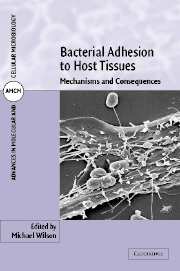Book contents
- Frontmatter
- Contents
- List of contributors
- Preface
- Part I Bacterial adhesins and adhesive structures
- Part II Effect of adhesion on bacterial structure and function
- Part III Consequences of bacterial adhesion for the host
- 10 Adhesion, signal transduction and mucosal inflammation
- 11 Adhesion of oral spirochaetes to host cells and its cytopathogenic consequences
- 12 Interactions between enteropathogenic Escherichia coli and epithelial cells
- 13 Host cell responses to Porphyromonas gingivalis and Actinobacillus actinomycetemcomitans
- Index
- Plate section
11 - Adhesion of oral spirochaetes to host cells and its cytopathogenic consequences
Published online by Cambridge University Press: 08 October 2009
- Frontmatter
- Contents
- List of contributors
- Preface
- Part I Bacterial adhesins and adhesive structures
- Part II Effect of adhesion on bacterial structure and function
- Part III Consequences of bacterial adhesion for the host
- 10 Adhesion, signal transduction and mucosal inflammation
- 11 Adhesion of oral spirochaetes to host cells and its cytopathogenic consequences
- 12 Interactions between enteropathogenic Escherichia coli and epithelial cells
- 13 Host cell responses to Porphyromonas gingivalis and Actinobacillus actinomycetemcomitans
- Index
- Plate section
Summary
INTRODUCTION
Oral spirochaetes colonize the gingival crevice and periodontal pocket adjacent to inflamed gingival tissues as their primary habitat. They are found most often as part of a loosely adherent mass of motile bacteria at the interface of the biofilm known as subgingival dental plaque and the sulcular and junctional epithelium lining the pocket. This location offers the opportunity to co-adhere with other bacteria and to adhere to a variety of host cells and extracellular matrix (ECM) components. Spirochaetes are motile, and they can translocate between epithelial cells, through the basement membrane, and even into the viscous ECM of the lamina propria of the gingiva. En route, whole cells or fragments shed from their outer sheath may become attached to epithelial cells, gingival fibroblasts, endothelial cells, and leukocytes, and thereby may initiate cascades of cellular responses that affect the normal functions of host cells and the remodelling of the periodontal tissues. Thus the adhesion of oral spirochaetes to ECM components and cells probably contributes to the exacerbation of periodontal lesions and to the chronicity of lesions by interfering with wound healing in sites where infections are not sufficiently suppressed by host defences or by therapy.
Most oral spirochaetes have not yet been cultivated in the microbiology laboratory (Qui et al., 1994). Until the advent of methodology based on molecular genetics, there was little understanding of the great diversity represented by this group, which was traditionally classified by cell size and by the number of periplasmic flagella originating at the poles of these long, slender bacteria.
- Type
- Chapter
- Information
- Bacterial Adhesion to Host TissuesMechanisms and Consequences, pp. 247 - 276Publisher: Cambridge University PressPrint publication year: 2002
- 2
- Cited by



